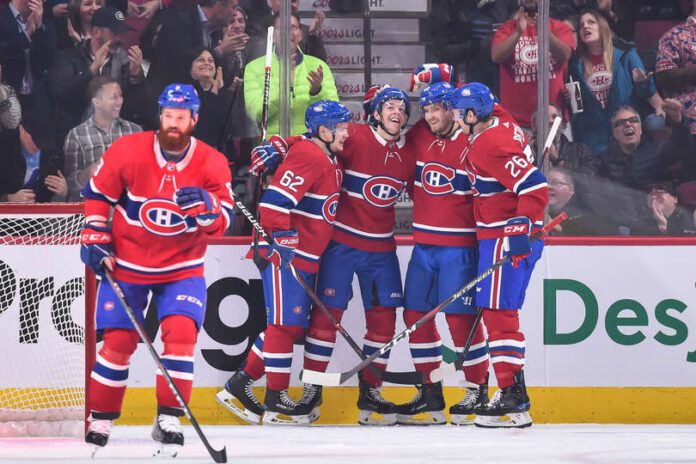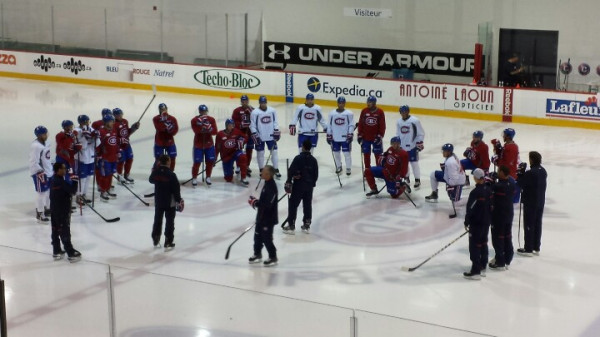
Fan Post | Jesperi Kotkaniemi, Canadiens, Habs, Marc Bergevin, Development, Draft, Laval Rocket, Offer Sheet, Carolina Hurricanes

All Habs Hockey Magazine is proud to provide a platform for guest writers to express their views on current issues. Today, we present a fan piece by Erin Manning on the development path of former Montreal Canadiens centre Jesperi Kotkaniemi.
If you would like to share your fan experiences or have an opinion to contribute, contact us.
===
ROCKET SPORTS MEDIA — On November 1, 2018, a rookie playing center for the Montreal Canadiens scored his first NHL goal. In that moment of triumph we saw two factors that would help lead that young player, Jesperi Kotkaniemi, to sign an offer sheet with the Carolina Hurricanes less than three years later.
The first factor was the skill involved in the play and the goal. Kotkaniemi helped recover the puck in the Habs’ own zone, raced up the ice beside his Finnish teammates Joel Armia and Artturi Lehkonen, and sent a quick shot short-side and high past the glove of the Washington Capitals’ Braden Holtby. It was a nice first period goal for the rookie’s first of his career.
When Kotkaniemi turned to the crowd, the other factor appeared: a radiant smile on the face of a young man who was still, no matter what role he was playing with the Montreal Canadiens, little more than a boy—a boy who did not belong full-time in the NHL.
The smile was back in the third period, when Kotkaniemi scored his second goal of the game (and his pro career) to spark the Canadiens comeback against the Capitals.
Desperate for a Center
Nobody thought he would be there already. Drafted at third overall, he was supposed to be a long-term project; everyone knew that. Kotkaniemi was supposed to go home to Finland and grow up before entering the hardest hockey league in the world.
It was his talent, his work ethic, and his competitive spirit that changed things at the Habs’ training camp. But the Habs were still in charge of this enthusiastic boy, and they needed to be the adults in the room who acknowledged that in spite of appearances to the contrary he wasn’t ready. They didn’t.
His introduction to the NHL happened before I became a hockey fan and started watching the Habs. My first year as a Habs fan was Kotkaniemi’s second year in the NHL, the year things began to unravel for him. As new hockey fans in Texas, you might think my husband and I would follow the Dallas Stars, our local team. But my husband was interested in the Montreal Canadiens because of a different young player, the rookie Nick Suzuki who was attracting lots of attention.
I noticed Kotkaniemi when my husband and I were watching games and trying to figure out mysteries like “offsides” and “icings” along with the rest of the game. I was confused—were there two rookies with the Habs? When I learned that Kotkaniemi was in his second year at the age of 19, I was surprised, and wondered if this was normal for hockey players.
I know now that it isn’t, and that it wasn’t good for Kotkaniemi, either.
A Development Detour
His injury-plagued sophomore year showed the error of the notion that Kotkaniemi had been ready for the big league at 18. Before the end of that season Kotkaniemi would go to the AHL, a departure some fans saw as ominous. The whispers that he was a bust began to rise as memories of his rookie year faded.
Kotkaniemi had a different view. In every interview he gave during that time, he expressed something other than disappointment: he was grateful for the opportunity to play at a lower level, to try to learn the North American game properly at a slightly slower pace, to have a coach who didn’t get angry when Kotkaniemi asked for explanations.
He was grateful for this tiny chance at development.
It didn’t last long. Kotkaniemi was injured after putting up 13 points in 13 AHL games. The injury was serious enough to end his season. Had it not been for a cascade of unusual events including the playoff bubble, Max Domi’s type-1 diabetes that delayed his postseason arrival, the play-in round where Kotkaniemi revealed his playoff beast mode to an astonished fan base (and equally astonished team), it’s possible that Kotkaniemi’s time in Montreal might have ended sooner than it did.
A Change in the Plan
Marc Bergevin was so overjoyed by the 2020 playoff performances of Nick Suzuki and Jesperi Kotkaniemi that he made bold moves in the offseason that followed, and declared both to be untouchable keys to the Habs’ future. A year later the locks have been changed as far as Kotkaniemi is concerned, in spite of a Stanley Cup run in which Kotkaniemi had an impact. What happened?
At the beginning of his third NHL season Kotkaniemi said he hoped he’d have his best year. It started that way; the youngest center on the team put up seven points in his first 13 games while centering a line that included Tyler Toffoli with either Joel Armia or Corey Perry on the other side.
By the 14th game of the season, Canadiens head coach Claude Julien was in trouble. The team’s hot start faded. Phillip Danault’s line scored at a lower rate than both Suzuki’s and Kotkaniemi’s lines. To spark Danault’s line, Julien took Tyler Toffoli from Kotkaniemi’s line and gave Kotkaniemi winger Tomas Tatar, who was in a scoring slump. That started the carousel of ever-shifting lines and strange deployment that would eventually ruin Kotkaniemi’s productivity.
Instability Yields Inconsistency
By the end of the regular season, Kotkaniemi would have 18 unique starting lines and would start 26 games with a different starting line than the one he’d had in the game or games just before. In an 82-game season, that would be like having 26 trios and starting 38 games with a different line than the one from the previous game.
Despite the carousel of wingers, Kotkaniemi was producing at about a 0.5 point-per-game rate for the first 34 games of the season. His first nine trios were spread over those 34 games. Kotkaniemi had nine more trios in the last 22 games, following the arrival of Eric Staal to take a slot at center on the team. In those games Kotkaniemi played on Danault’s wing six times, when he hadn’t played on the wing for two years. The Habs were playing four games a week by then and had little time to practice.
Kotkaniemi played all 56 regular season games, but was told he would be scratched to begin the playoffs.
In an interview, coach Dominique Ducharme compared Kotkaniemi to a crooked nail they hadn’t had time to straighten out and had been forced to keep hammering—a metaphor that perhaps revealed more than Ducharme intended. The rigors of the season with Kotkaniemi’s unusual deployment had revealed some of the missing pieces of the young center’s development, and his coach saw him as a player who was inconsistent.
Writing on the Wall
Though Kotkaniemi entered the playoffs in the second game against Toronto, scored the game-winning overtime goal in the sixth game of that series, and went on to have a positive impact in the playoffs, he was scratched again in the last two games of the Stanley Cup Final. Players with limiting injuries were preferred to him in the lineup; that likely told Kotkaniemi everything he needed to know about his future in Montreal.
If it didn’t, Marc Bergevin’s inability to say anything positive about the likelihood that Kotkaniemi would play as second line center this fall surely clued Kotkaniemi—and his agent—in. Bergevin said something else important: he said he often forgot that Kotkaniemi was still a young player.

It’s easy to go back to the November 2018 game in his rookie season and see the paradox of a skilled goal followed by a boy’s grin after a comment like that. Kotkaniemi’s talent made the Habs skip over development steps because they needed him to play. The resulting inconsistency in Kotkaniemi’s play that grew over time ended up hurting him and them.
With no reason to believe the situation would ever change in Montreal, Jesperi Kotkaniemi signed an offer sheet with a team that already has a development plan in place for him, along with a coach who is skilled with young players. The situation could have been avoided if, back in his rookie year, Kotkaniemi’s coaches and general manager in Montreal could have stopped their rapt-eyed contemplation of his undeniable talent long enough to see that their third overall draft pick was still a boy.
By Erin Manning, Guest Writer
All Habs Hockey Magazine
Copyright © 2021 Rocket Sports
Canadiens Connection podcast
Current Habs topics were discussed on this week’s episode of the Canadiens Connection. Listen, share and subscribe!
And this week we have a BONUS episode of the Canadiens Connection podcast for you with supplementary discussion to episode 153!







![Prospect Report: Habs Development Camp Testing [GALLERY]](https://habshockeyreport.com/wp-content/uploads/2014/07/IMG_2897.jpg)

![Habs Western Road Trip in Pictures [GALLERY]](https://habshockeyreport.com/wp-content/uploads/2014/03/476898185_slide.jpg)
This was simple to explain a draft misfire or bad guess. 50/50 ODDS at best that any 1st round draft pick works out.There are lots of disappointments for that draft year. Do you think Caufield needs more time to develop? If the talent is there 3 years is lots of time to show it. KK may someday be a decent 2 or 3 line winger but not the 1st line centre the Habs wanted.
First, every player is responsible for their own development. There have been many players who come into the NHL straight out of the draft and had success. Competition is the best way to develop any player. Secondly, KK would have been absolutely crazy not to sign the offer sheet and its massive overpay and I wish him nothing but success. That being said if he does not live up to his contract then I expect him to be put on waivers before the trade deadline to free up CAP space for the Canes if they are in a playoff hunt. That will put him in the AHL to finish off his 1-year contract and it will be interesting to see what he gets offered for the next contract.
Comments are closed.